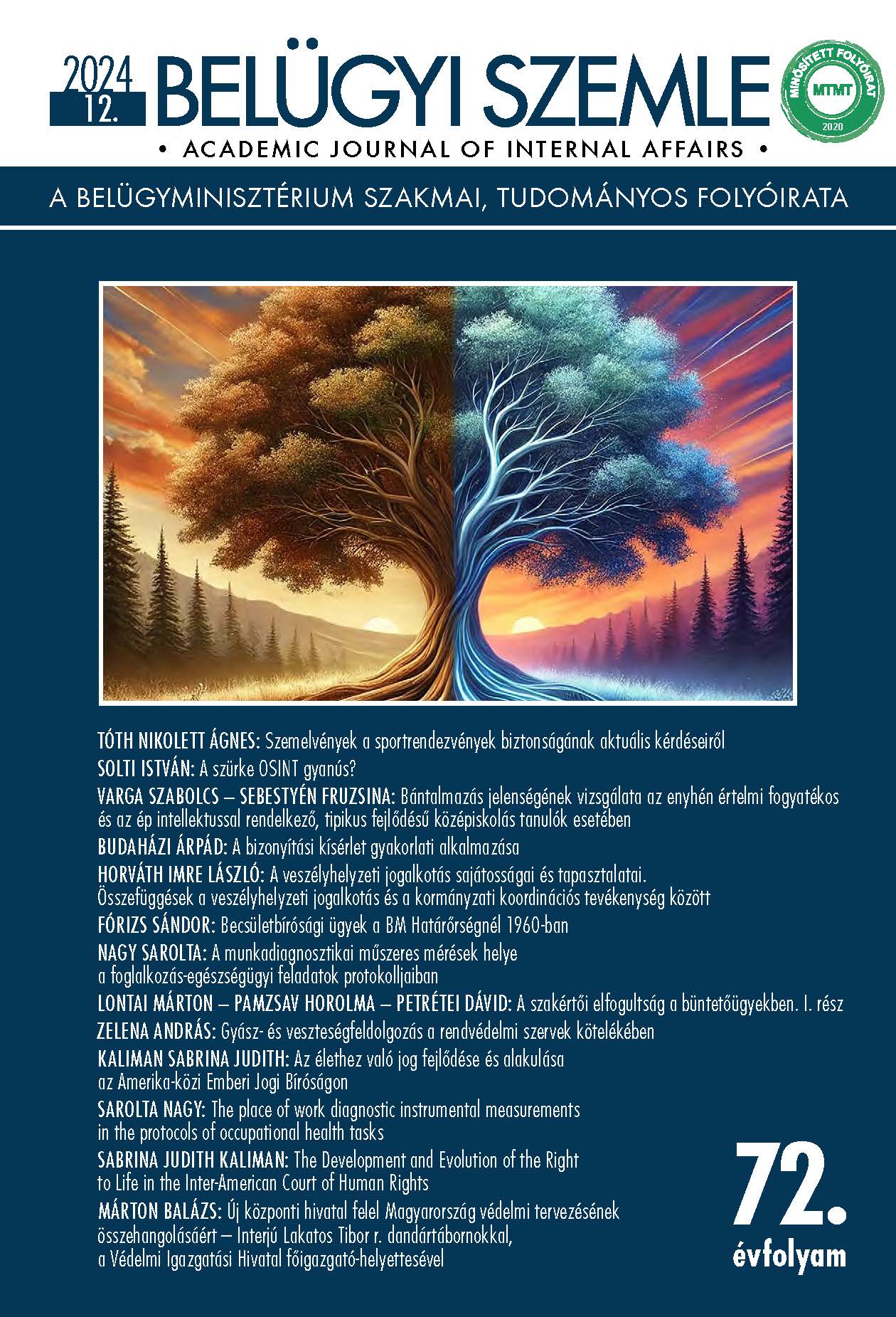Abstract
Aim: The study aims to show the potential of the proof experiment and its limitations and implementation flaws. It also aims to examine why its use is rare.
Methodology: In the study framework, the author consulted prosecutors, investigators, investigators, judges and defence lawyers, conducted a file search at the Metropolitan Court of Justice and reviewed publications on the legal instrument.
Findings: It is typically used during the investigation and in the first instance trial, but there are also examples of it being held in the second instance trial. It is used when it is necessary to clarify whether an event or phenomenon could have happened as the authorities assume based on the available data or to refute what the accused or witnesses have said. Practice shows that it is rarely used, as only a tiny proportion of cases require an attempt to prove. A characteristic of an evidentiary hearing is that it may require considerable preparation and sometimes many participants, so its organisation is only sometimes straightforward and often time-consuming. However, the result can help the prosecution if it is carried out correctly and no mistakes are made. The advantage of an evidentiary experiment is that it can be repeated, even at another stage of the proceedings, so that any execution error can be corrected. Contrary to popular perception, an attempt to take evidence does not necessarily slow criminal proceedings. As the cases presented in this study show, in many cases, an attempt at taking evidence speeds up criminal proceedings by providing answers to relevant questions.
Value: The study could change law enforcement practice to more frequently use legal instruments to prove and reduce the potential for enforcement errors. Monitoring changes could be the subject of further publications.
References
Angyal M., Bezsenyi T., Bói L., Farkasné Halász H., Girhiny K., Nyitrai E. & Tirts T. (2017). Tisztjelölt hallgatók a kriminalisztikai megismerés startkövénél (egy szimulált baleset tanulságai). Magyar Rendészet, 17(2), 27–66.
Balogh J., Edvi Illés K. & Vargha F. (1909). A Bünvádi perrendtartás magyarázata. Második kötet. Grill Károly Könyvkiadóvállalata.
Bócz E. & Finszter G. (2008). Kriminalisztika joghallgatóknak. Magyar Közlöny Lap- és Könyvkiadó.
Bócz E. (2006). Büntetőeljárási jogunk kalandjai – sikerek, zátonyok és vargabetűk. Magyar Hivatalos Közlönykiadó.
Bócz E. (2008). Kriminalisztika a tárgyalóteremben. Magyar Közlöny Lap- és Könyvkiadó.
Budaházi Á. (2017). A bizonyítási kísérlet egy empirikus kutatás tükrében. Magyar Rendészet, 17(5), 67–82.
Budaházi Á. (2018): A bizonyítási kísérlet büntető eljárásjogi és kriminalisztikai aspektusai. Magyar Jog, 65(4), 202-209.
Elek B. (2008). A vallomás befolyásolása a büntetőeljárásban. Tóth Könyvkereskedés és Kiadó Kft.
Fenyvesi Cs. (2014) A kriminalisztika tendenciái. A bűnügyi nyomozás múltja, jelene, jövője. Dialóg Campus Kiadó.
Fenyvesi Cs. (2017). A bizonyítási kísérlet és a hit. Iustum Aequum Salutare 13(1), 99–106.
Fenyvesi Cs. (2021). A felismerési kísérlet összehasonlítása más bizonyítási cselekményekkel. Magyar Rendészet, 21(3), 43–56. https://doi.org/10.32577/mr.2021.3.3
Fenyvesi Cs., Herke Cs. & Tremmel F. (2022). Kriminalisztika. Ludovika Egyetemi Kiadó.
Gárdonyi G. & Hautzinger Z. (2021). A kriminalisztikai kutatások fejlesztésének lehetősége. Belügyi Szemle, 69(10), 1725–1740. https://doi.org/10.38146/BSZ.2021.10.3
Girhiny K. (2017a). Gondolatok a helyszíni kihallgatásról a bizonyítási eljárások tükrében. In Gaál Gy. & Hautzinger Z. (Szerk.). Szent Lászlótól a modernkori magyar rendészettudományig. Pécsi Határőr Tudományos Közlemények XIX. (pp. 189–196). Magyar Hadtudományi Társaság Határőr Szakosztály Pécsi Szakcsoportja.
Girhiny K. (2017b). The relevancy of questioning on the scene in case of exhibits. Studia Universitatis Babes-Bolyai, 62(2), 95–101. https://doi.org/10.24193/SUBBiur.62(2017).2.10
Gyakorlati nyomozástan (1947). Magyar Államrendőrség Országos Szaktanulmányi Felügyelője.
Graff, G. W. (2016). Case Management: The Foundation for Crime Scene
Reconstruction. ACSR Journal, 2(20), 35–44.
Háger T. (2013). Az ítéleti tényállás megalapozottságával kapcsolatos egyes kérdések a büntetőperben. Jogelméleti Szemle, 14(1), 31–44.
Katona G. (1986). Még egyszer Magda János bűnügyéről. Belügyi Szemle, 24(8), 96–104.
Nyitrai E. (2021). A sorozat-bűncselekmények nyomozásának metodikája. Belügyi Szemle, 69(2). különszám, 31–47. https://doi.org/10.38146/BSZ.SPEC.2021.2.2
Petrétei D. (2019). Azonosításelmélet. In Angyal M. (Szerk.), Kognitív kriminalisztika. Ismeret – elmélet – történet (pp. 145–147). Dialóg Campus.
Petrétei D. (2020). Gondolatok a kriminalisztikai azonosításelméletről. Belügyi Szemle, 68(2), 7–22. https://doi.org/10.38146/BSZ.2020.2.1

This work is licensed under a Creative Commons Attribution-NonCommercial-NoDerivatives 4.0 International License.
Copyright (c) 2024 Academic Journal of Internal Affairs
